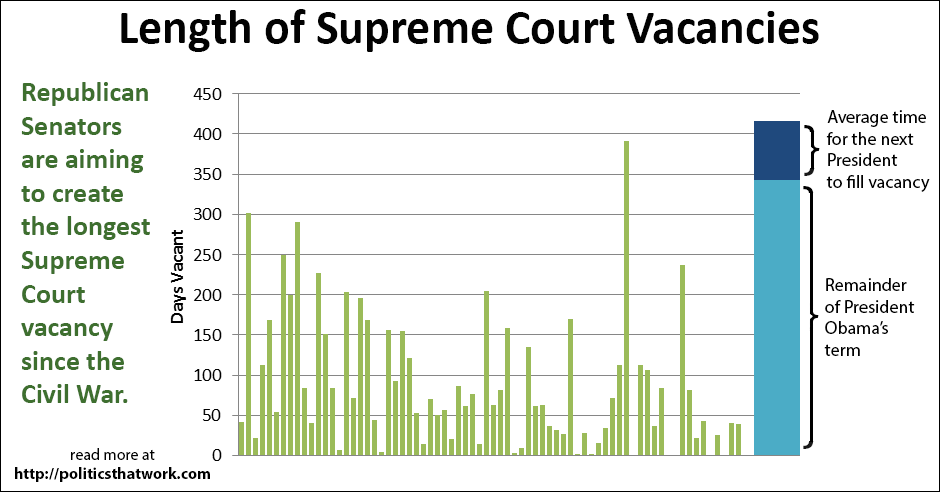
Republican Senators are Aiming to Create the Longest Supreme Court Vacancy Since the Civil War
Description: The green bars show the lengths of all of the Supreme Court vacancies since the Civil War in days. The blue bar shows the amount of time that the seat left empty by the death of Justice Antonin Scalia would likely remain empty if the Republicans in the Senate refuse to confirm any judge nominated by President Obama. The light blue portion of the blue bar represents the remainder of President Obama's term and the dark blue portion indicates the average time it takes to nominate and confirm a Supreme Court Justice.
Sources: U.S. Supreme Court
Data: Excel
Last updated: February 13, 2016
Discussion: Within hours of the passing of Supreme Court Justice Antonin Scalia, Republican Senate Majority Leader Mitch McConnell vowed to block any replacement nominated by President Barack Obama. Holding a Supreme Court seat vacant for that long would be an unprecedented move since the Civil War.
If it takes the average time for the next president to nominate a Justice and to have them confirmed, the Supreme Court would be one Justice short for 415 days. It has been argued in the past, controversially, that the Senate should refuse to confirm Supreme Court nominees during the final six months of a lame duck presidency, but holding out for eleven months on the basis of the party of the President, rather than the particular nominees, would be a first in U.S. history.
Only one vacancy since the Civil War has lasted longer than 300 days, That was the 391 days between Justice Abe Fortas's resignation in 1969 and Justice Harry Blackmun's placement on the court in 1970. That extraordinarily long vacancy was the result of two factors. First, it took President Nixon three months to make a nomination because his first choice declined the offer. Second, the first two nominees were advocates of racial segregation and were rejected by the Senate.
See more graphs about: Legal
If it takes the average time for the next president to nominate a Justice and to have them confirmed, the Supreme Court would be one Justice short for 415 days. It has been argued in the past, controversially, that the Senate should refuse to confirm Supreme Court nominees during the final six months of a lame duck presidency, but holding out for eleven months on the basis of the party of the President, rather than the particular nominees, would be a first in U.S. history.
Only one vacancy since the Civil War has lasted longer than 300 days, That was the 391 days between Justice Abe Fortas's resignation in 1969 and Justice Harry Blackmun's placement on the court in 1970. That extraordinarily long vacancy was the result of two factors. First, it took President Nixon three months to make a nomination because his first choice declined the offer. Second, the first two nominees were advocates of racial segregation and were rejected by the Senate.
See more graphs about: Legal
Political and Economic News
EPI: The Tax Cuts and Jobs Act isn’t working and there’s no reason to think that will change
CNN: Trump ordered Mattis to screw Amazon
Elijah Cummings: We are in a fight for the soul of our democracy
Pro Market: The Cost of America’s Oligopoly Problem
...more





